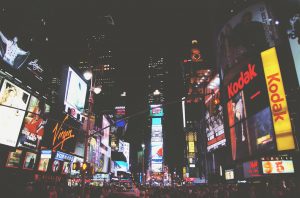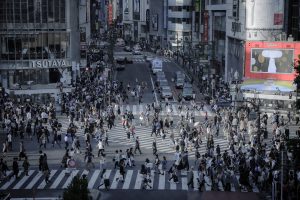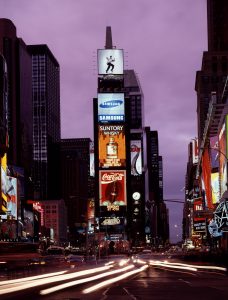Looking behind the shiny, shiny lights – The tremendous rise of DOOH Advertising
Looking behind the shiny, shiny lights – The tremendous rise of DOOH Advertising

Imagine walking around Amsterdam Centraal Station during the day. Feel the eyes of strangers coveting you, hear the sounds of the multiple vehicles whizzing by, see the hundreds of screens inviting you to have a look at them. Some will be huge – displaying a few ads in rotation. An ad for McDonalds appears; you hunt for change, and head out to buy whatever is on the screen. Easy!
“Nowadays, everything can be an advertising platform, we’re not able to create a division between what is, and what is not, a communication channel” (Kelley, Sheehan, & Jugenheimer 2015)
Change within the ad industry has been a slow, yet dynamic, moving away from past systems to a more digitalised infrastructure. Over the last few years, the advertising industry has seen a lot of ups and downs. According to The Seven Stars, print is on the decline, and other multi-platform ad revenues have fallen by around 10% in 2017. Contrary to this Outdoor and Digital Out-Of-Home (DOOH or Digital Signage) markets have been on the upswing. As reported by Allied Market Research, the DOOH market is projected to grow by around 12.60% by 2023, with as much as 16% growth in 2018. DOOH is an emerging platform for advertisers since it is always revolutionising itself, and creating new avenues for content distribution every other week. For a segment to rise so tremendously within an industry, there has been much chatter about just why DOOH is on the rise, and what it means for the future of the advertising industry.
Fast-forwarding infrastructure
The results of a study by Martinez-Martinez, Aguado & Boeykens (2017) necessitated “the need for adapting capabilities in a rapidly evolving advertising sector, in which new technologies give rise to new complex processes with important ethical and reputational implications”.

The advertising industry has always felt the need to evolve, and DOOH advertising is the latest evolution. From malls to airports, retail stores to information boards, digital advertising can be seen all around. In 2018 the UK DOOH market will account for around 47% of all Out-Of-Home (OOH) advertising, according to The Identity Group. This is due to the mass ordering of digital signage to capture an ever-growing target segment – everyone that leaves their home. Expanding from 2056 digital screens in 2009 to over 17,000 projected screens in 2017, (from The Seven Stars) the UK will be at the heart of an industry that is changing the nature of advertising with advanced, well-placed, innovative infrastructures.

Gone are the days of plastering up short-term billboards – the tacky paper unit billboards and posters. According to Mattern (2013), “Infrastructural systems are not necessarily static; often they are even mutable, portable, transient…” How right she is! Today, a billboard is no more an inanimate object – it is connected to facial recognition cameras, posters that you can touch and feel, and technology that can detect the weather (IE Digital)! We now have ad “pods”, which have double sided, high-bright LED screens, equipped with “remote management technology,” which dramatically decreases the need for manual maintenance. Instead, arrays of sensors report problems back to a home base (Giles 2018). This real-time problem detection technology makes it very easy for advertisers to see what problems they face with the infrastructure they use, while interacting with consumers through surveillance and real-time data tracking – which a lot of experts consider one of the greatest strengths of DOOH.
Targeting consumers on the go
“Through programmatic OOH, creative messages are displayed by analysing historical and real-time data encompassing a range of sources such as weather, sporting events, leisure, and more to ensure the right billboard at the right site shows the most relevant ads at the right time.” (Ghosh 2017)
While Roger Clarke claims to have come up with the word, Burdick coined the term “Dataveillance” back in 1973. The term describes how one can monitor, process and collect our online data. Past research has strongly indicated that while digital targeting can improve a consumer’s response to ads, marketers can see a negative when they don’t have access to consumer data (Goldfarb & Tucker 2010). According to a study by Ocean Outdoor, full-motion digital ads have the ability to influence a consumer just as much as a television ad. One of the main features of DOOH is that, unlike other personal digital advertising, you can’t turn it off or opt out of it (Simmons 2018). It simply exists around you, free to influence you in the way that advertisers see fit.
In recent years, it has led advertisers to seek new ways of seeking out potential customers, by targeting them through the DOOH ads. There are many ways to target consumers, though infrastructural additions, based on their movement patterns and even through direct-from-source data, like weather conditions. Much of this has to do with a technological partnership that eluded (and it could be argued – killed) television – the smartphone.

A marriage made in tech
“For today’s digital signage developers, the proven, high-volume platform with integrated computing and connectivity offers the latest cellular, multimedia and machine learning capabilities needed for signage solutions” (Torrance 2018)
Unlike television, which failed to keep up with the smartphone ambush, DOOH has created a unique place within today’s smartphone framework. The two platforms compliment and collaborate with each other, offering “data maximisation, customer impression targeting, multi screen retargeting, geo fencing and attribution” (Frey 2018). Frey (2018) continues to say that by using your location data and techniques such as Wifi-sniffing, facial detection, geo-targeting and mobile ID aggregation, companies can track usage and interaction with screens.
However, the most unique outcome of the smartphone revolution when combined with innovative digital marketing is the emotional and human aspect of technology. Consumers can feel emotionally connected to a brand, through the use of Augmented Reality, by interacting with digital signage with their voices, the touch of a hand, a simple gesture, or even by just walking by!

Concerned or Captivated?
There have been many concerns based on privacy, unauthorised surveillance and the use of meta-data with regards to DOOH. Governments around the world have been pressed into passing laws that help secure consumers’ rights to prevent piracy of data, which in turn restricts ad agencies from acquiring even more data caches. However, DOOH has been able to successfully build an emerging platform in today’s advertising world. Parks (2017) mused that “though we live in a digital age, and processes are increasingly technologized, not all infrastructures are fully automated,” which is very much true. The future of DOOH will rest on human connection, which with DOOH will combine to form a brand new infrastructural system within advertising.
Bibliography:
Burdick, R E, editor. Surveillance, Dataveillance, and Personal Freedoms: Use and Abuse of Information Technology. January, Columbia Human Rights Law Review, 1973
Frey, Barry. “What’s So Great About Digital Out of Home (DOOH)?” My TechDecisions, 12 Jan. 2018, mytechdecisions.com/mobility/whats-great-digital-home-dooh/.
Ghosh, Abhinandan. “Why Digital-Out-of-Home (DOOH) Is the New Kid on the Block.” MarTech Advisor, 5 Oct. 2017, www.martechadvisor.com/articles/ads/why-digital-out-of-homedooh-is-the-new-kid-on-the-block/.
Giles, Anna. “The Rise of Digital in OOH Mall Advertising.” Bubble, Anna Giles Http://Bubbleoutdoor.com/Wp-Content/Uploads/2018/04/WEB_BUBBLE_RGB-1.Png, 30 Apr. 2018, bubbleoutdoor.com/the-rise-of-digital-in-ooh-mall-advertising/.
Goldfarb, Avi, and Catherine Tucker. “Privacy Regulation and Online Advertising.” SSRN Electronic Journal, 29 Oct. 2010, doi:10.2139/ssrn.1600259.
Hobbs, Thomas, et al. “How Outdoor’s Digital Transformation Is Winning over Advertisers.” Marketing Week, 24 July 2017, www.marketingweek.com/2017/07/24/outdoor-advertising-digital-transformation/.
Kelley, Larry D., et al. Advertising Media Planning: a Brand Management Approach. Routledge, Taylor & Francis Group, 2015.
Martínez-Martínez, Inmaculada J., et al. “Ethical Implications of Digital Advertising Automation: The Case of Programmatic Advertising in Spain.” El Profesional De La Información, vol. 26, no. 2, 2017, p. 201., doi:10.3145/epi.2017.mar.06.
Mattern, Shannon. “Infrastructural Tourism.” Places Journal, no. 2013, 1 July 2013, doi:10.22269/130701.
Parks, Lisa. 2015. “‘Stuff You Can Kick’: Toward a Theory of Media Infrastructures.” Between Humanities and the Digital. Ed. Patrik Svensson and David Theo Goldberg. Cambridge, MA: MIT Press. 335–274. Web. 18 Sept. 2016.<https://www.academia.edu/16426095/Stuff_You_Can_Kick_Toward_a_Theory_of_Media_Infrastructures>
Rogers, Charlotte, et al. “How OOH Advertising Is Moving beyond Awareness.” Marketing Week, 16 Nov. 2016, www.marketingweek.com/2016/11/15/the-many-faces-of-outdoor/.
Simmons, Candice. “5 Hottest Trends in Digital Out-of-Home Advertising Right Now.” Target Marketing, Target Marketing Magazine, 29 June 2018, www.targetmarketingmag.com/post/the-5-top-trends-in-ooh-advertising/.
Torrance, Jeffery. “The Future of Digital Signage Is Built on Smartphones.” Digital Signage Connection, Digital Signage Connection, 26 June 2018, www.digitalsignageconnection.com/the-future-of-digital-signage-is-built-on-smartphones.
All pictures taken from Pixabay:
https://pixabay.com/en/piccadilly-circus-people-crowd-busy-926802/
https://pixabay.com/en/times-square-new-york-city-dusk-555795/
https://pixabay.com/en/shibuya-intersection-skyline-2328029/
https://pixabay.com/en/smartphone-face-woman-eyes-view-1445448/
https://pixabay.com/en/night-dark-crowd-people-new-york-692261/